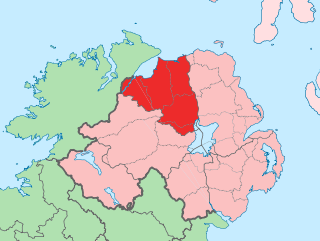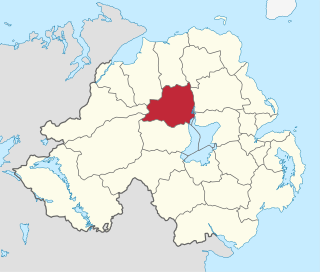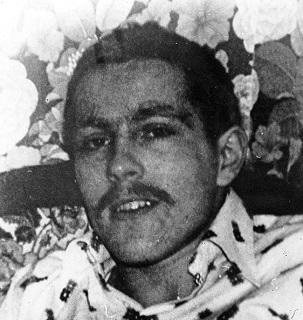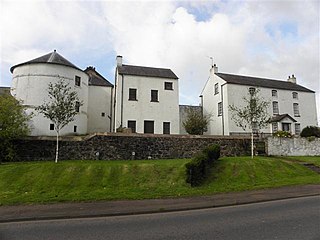
Seamus Justin Heaney was an Irish poet, playwright and translator. He received the 1995 Nobel Prize in Literature. Among his best-known works is Death of a Naturalist (1966), his first major published volume. Heaney was and is still recognised as one of the principal contributors to poetry in Ireland during his lifetime. American poet Robert Lowell described him as "the most important Irish poet since Yeats", and many others, including the academic John Sutherland, have said that he was "the greatest poet of our age". Robert Pinsky has stated that "with his wonderful gift of eye and ear Heaney has the gift of the story-teller." Upon his death in 2013, The Independent described him as "probably the best-known poet in the world".

County Londonderry, also known as County Derry, is one of the six counties of Northern Ireland, one of the thirty two counties of Ireland and one of the nine counties of Ulster. Before the partition of Ireland, it was one of the counties of the Kingdom of Ireland from 1613 onward and then of the United Kingdom after the Acts of Union 1800. Adjoining the north-west shore of Lough Neagh, the county covers an area of 2,118 km2 (818 sq mi) and today has a population of about 252,231.

Magherafelt District Council was a district council in County Londonderry in Northern Ireland. It was merged with Cookstown District Council and Dungannon and South Tyrone Borough Council on 1 April 2015 under local government reorganisation in Northern Ireland becoming Mid-Ulster District Council.

Lough Neagh is a freshwater lake in Northern Ireland and is the largest lake on the island of Ireland and in the United Kingdom. It has a surface area of 151 square miles and supplies 40% of Northern Ireland's water. Its main inflows come from the Upper River Bann and River Blackwater, and its main outflow is the Lower River Bann. Its name comes from Irish Loch nEachach[ˌl̪ˠɔx ˈn̠ʲahəx], meaning "Eachaidh's lake". The lough is owned by the Earl of Shaftesbury and managed by Lough Neagh Partnership Ltd.

Francis Joseph Sean Hughes was a volunteer in the Provisional Irish Republican Army (IRA) from Bellaghy, County Londonderry, Northern Ireland. Hughes was the most wanted man in Northern Ireland until his arrest following a shoot-out with the Special Air Service (SAS) in which an SAS soldier was killed. At his trial, he was sentenced to a total of 83 years' imprisonment; he died during the 1981 Irish hunger strike in HM Prison Maze.
Heaney is a surname of Irish origin. It is an Anglicisation of the Gaelic Ó hEignigh, thought to be based on the Gaelic Eochaidh a personal name meaning "horseman". It was mistakenly thought to derive from Éan, Gaelic for Bird. Versions of it are written in the Annals from the 8th century and has a diverse array of modern derivations and origins.

Castledawson is a village in County Londonderry, Northern Ireland. It is mostly within the townland of Shanemullagh, about four miles from the north-western shore of Lough Neagh, and near the market town of Magherafelt. At the 2011 Census it had a population of 3,293.

Loughgall is a small village, townland and civil parish in County Armagh, Northern Ireland. It is in the historic baronies of Armagh and Oneilland West. It had a population of 282 people in the 2011 Census. Loughgall was named after a small nearby loch. The village is surrounded by orchards.

Desertmartin is a small village in County Londonderry, Northern Ireland. It is four miles from Magherafelt, at the foot of Slieve Gallion. In the 2001 Census the greater Desertmartin area had a population of 1,276. It lies within Desertmartin parish, Mid-Ulster District, and the historic barony of Loughinsholin. Neighbouring settlements include Draperstown, Magherafelt, Moneymore, and Tobermore.

Ballyronan is a village and townland in County Londonderry, Northern Ireland, on the north western shore of Lough Neagh. The village is 5 miles (8 km) from Magherafelt and 12 miles (19 km) from Cookstown. It is situated within Mid-Ulster District.
A total of eleven people were killed in violence relating to the Northern Irish Troubles in the town of Magherafelt, County Londonderry. Nine were killed by the Irish Republican Army (IRA), including three IRA members killed by the premature explosion of their own bomb while travelling through Magherafelt. One was killed by a non-specific republican group and another by the opposing Ulster Freedom Fighters (UFF). Of the others killed by the IRA, four were Protestant civilians. Three of them were killed in two separate car bomb explosions. The fourth Protestant civilian was shot because his firm was a contractor for the British Army and the Royal Ulster Constabulary (RUC). The IRA's other two victims were both Protestant members of the security forces, one from the RUC and the other from the Ulster Defence Regiment. Both were off duty when killed. The man killed by the UFF was a Sinn Féin councillor who was shot in his workplace. The man killed by the non-specific republican group was a Catholic civilian.

Bellaghy Wolfe Tones Gaelic Athletic Club is a Gaelic Athletic Association club based in Bellaghy, County Londonderry, Northern Ireland. The club is a member of Derry GAA and currently competes in gaelic football and camogie.

Dunasead Castle, sometimes known as Baltimore Castle, is a 17th-century fortified house situated in the town of Baltimore in County Cork, Ireland. The tower house is built on the site of an earlier Norman-era structure, which itself replaced an earlier Bronze Age ringfort. Traditionally associated with the chiefs of clan O'Driscoll, the castle was purchased and restored by members of the McCarthy family in the late 1990s, and partially opened to the public from 2005.

Killeshandra or Killashandra, is a village in County Cavan, Ireland. It is 20 kilometres (12 mi) west of Cavan Town in the centre of County Cavan's lakeland and geopark region and the Erne catchment environment of rivers, lakes, wetlands and woodland. Together with the Lough Oughter Special Protected Area (SPA), it has been recognised by the EU programme for wildlife Natura 2000 since 2010. Killeshandra is noted by Fáilte Ireland as an "Angling Centre of Excellence", and as a hub for the Cavan Walking Festival which takes place in May each year. There are several looped walking and cycling trails in Killykeen Forest Park. The town is also home to Killeshandra Gaelic Football Club, known locally as the Killeshandra Leaguers. Rockfield Lake, which is popular with anglers, is a few kilometres southwest of the town.
Events during the year 1956 in Northern Ireland.

Portnablagh is a small village in County Donegal in Ulster, the northern province in Ireland. Portnablagh is located on the north-west coast of County Donegal, specifically the west side of Sheephaven Bay. It is on the N56 road.

Human Chain is the twelfth and final poetry collection by Seamus Heaney.It was first published in 2010 by the Faber and Faber.

That part of the United Kingdom called Northern Ireland was created in 1922, with the partition of the island of Ireland. The majority of the population of Northern Ireland wanted to remain within the United Kingdom. Most of these were the Protestant descendants of settlers from Great Britain.

The Seamus Heaney HomePlace is an arts and literary centre in Bellaghy, County Londonderry, Northern Ireland. It displays the life and work of Seamus Heaney.

Bellaghy Bawn is a fortified house and bawn in Bellaghy, County Londonderry, Northern Ireland.




















